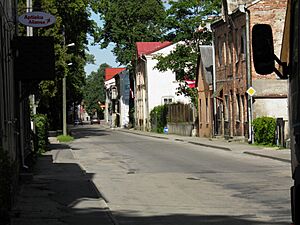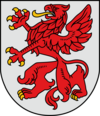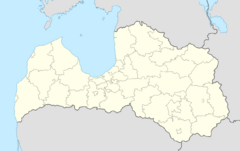Jaunjelgava facts for kids
Quick facts for kids
Jaunjelgava
|
||
|---|---|---|
|
Town
|
||
 |
||
|
||
| Country | Latvia | |
| Municipality | Aizkraukle Municipality | |
| Town rights | 1647 | |
| Area | ||
| • Total | Lua error in Module:Wd at line 1,575: attempt to index field 'wikibase' (a nil value). km2 (Formatting error: invalid input when rounding sq mi) | |
| • Land | Lua error in Module:Wd at line 1,575: attempt to index field 'wikibase' (a nil value). km2 (Formatting error: invalid input when rounding sq mi) | |
| • Water | Expression error: Unexpected < operator. km2 (Formatting error: invalid input when rounding sq mi) | |
| • Rural territory | 5.1 km2 (2.0 sq mi) | |
| Population
(2024)Lua error in Module:Wd at line 1575: attempt to index field 'wikibase' (a nil value).
|
||
| • Total | 1,713 | |
| Time zone | UTC+2 (EET) | |
| • Summer (DST) | UTC+3 (EEST) | |
| Postal code |
LV-5134
|
|
| Calling code | +371 651 | |
| Number of city council members | 9 | |
| Website | http://www.jaunjelgava.lv | |
Jaunjelgava is a town in Latvia, a country in Europe. It's located on the left side of the Daugava River in the Selonia region. The town is about 80 kilometers (about 50 miles) southeast of Riga, the capital city of Latvia. In 2020, about 1,762 people lived there. Its name, Jaunjelgava, means "New Jelgava."
Contents
History of Jaunjelgava
Early Days and Trade
It seems people didn't live exactly where Jaunjelgava is now before the 1400s. However, a Selonian fort called Sērene hillfort was located about 5 kilometers (3 miles) away. Around 1450, a country estate called Vecsērene manor was built nearby.
During the 1400s, this area became important for trade. Merchants from Riga would stop here. They would move their goods from boats to carriages because the Daugava River had rapids that made it hard to travel further downstream. Because of this, a small port grew in the area.
Founding and Growth of the Town
In 1567, Gotthard Kettler, who was the Duke of Courland and Semigallia (a historical region), called the small port Neustadt, which means 'new town' in German. In 1590, the next Duke, Friedrich Kettler, started a town market and gave Neustadt village rights. About 60 families lived there at that time.
The village was badly damaged in 1621 during a war between Poland and Sweden. It was rebuilt in 1646. Friedrich Kettler's widow, Elisabeth Magdalena of Pomerania, renamed the town Friedrichstadt to honor her husband. In 1647, the King of Poland, Władysław IV Vasa, officially gave Friedrichstadt town rights and approved its coat of arms.
In 1652, a Lutheran church was built in the town because Duke Jacob Kettler ordered it. The town grew quickly in the second half of the 1600s. After the Second Northern War, it became a very important place for transporting goods.
Challenges and Changes
In 1710, a serious disease called the plague spread through the town. In 1713, Russian forces defeated the Swedes near the city. The town also suffered from several big fires in the 1700s. Four major floods caused a lot of damage, with the biggest one in 1778 destroying about 100 houses.
In 1795, Friedrichstadt became part of the Russian Empire. This happened during the Third Partition of Poland, when the Duchy of Courland and Semigallia was taken over by Russia. During Napoleon's invasion of Russia in 1812, some small battles happened around the town. In 1831 and 1848, another disease, cholera, caused problems.
Trade and Decline
In the first half of the 1800s, the town did very well because of its merchant activities. Local people owned warehouses and taverns (inns) for rafters who floated goods down the river. They also transported goods by carriage to Jacobstadt. In 1820, there were 24 taverns in the town.
However, things changed when the Riga–Daugavpils Railway line opened in 1861. The Daugava River waterway became less important for transport, and so did the town. Even so, in the late 1800s, Jaunjelgava still had about 10 banks, many businesses, and a hospital. In 1909, telephone service connected Friedrichstadt to Riga and Jelgava. By 1914, the city had 7,300 people.
Modern Times and Renaming
The town was heavily damaged during the Latvian War of Independence. From October to November 1919, fierce fighting took place near the city. The Latvian army eventually freed the town from the West Russian Volunteer Army. After the war, in 1925, the city's population had dropped to only 1,577 people.
During the time of the Republic of Latvia, the town was renamed Jaunjelgava, which means "New Jelgava." In the 1930s, a dam about 3.5 kilometers (2.2 miles) long and 3 meters (10 feet) tall was built to protect the town from floods.
During World War II, Jaunjelgava was under Soviet control from 1940. Then, it was under German control from July 1, 1941, until September 18, 1944.
The Jewish Community of Jaunjelgava
Jaunjelgava was once home to a large Jewish community, like many other shtetls (small towns with a large Jewish population) in the Pale of Settlement (an area in the Russian Empire where Jews were allowed to live). The Jewish community in Jaunjelgava started in the late 1600s. In 1858, the first Jewish school opened in the town. By 1897, out of a population of 5,223 people, 3,800 were Jewish.
By 1935, the number of Jewish residents had decreased to about 25% of the city's population. Some were deported in June 1941. On August 2, 1941, during the Holocaust, the town's Jewish community was tragically ended by German troops.
Jaunjelgava Municipality
In 2009, Jaunjelgava joined with six nearby communities to form a local government district. This means they work together to manage local services and decisions.
Gallery
See also
 In Spanish: Jaunjelgava para niños
In Spanish: Jaunjelgava para niños









